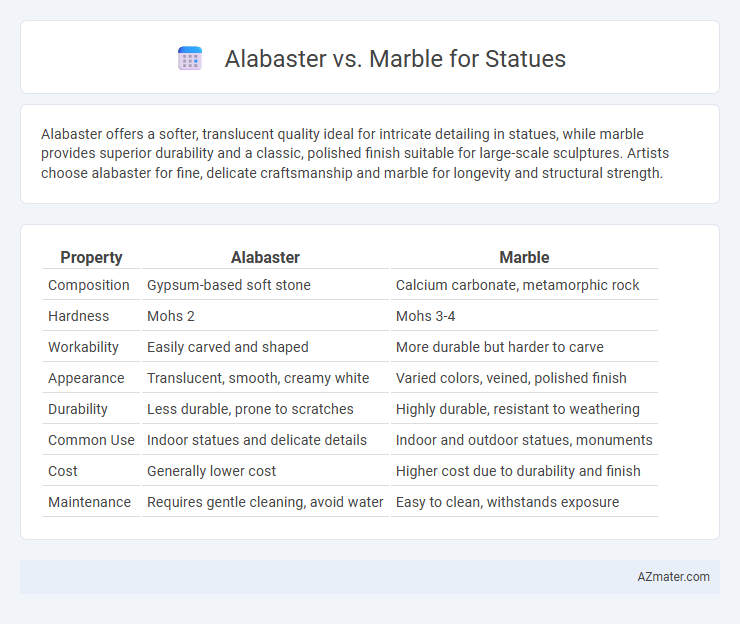Alabaster offers a softer, translucent quality ideal for intricate detailing in statues, while marble provides superior durability and a classic, polished finish suitable for large-scale sculptures. Artists choose alabaster for fine, delicate craftsmanship and marble for longevity and structural strength.
Table of Comparison
| Property | Alabaster | Marble |
|---|---|---|
| Composition | Gypsum-based soft stone | Calcium carbonate, metamorphic rock |
| Hardness | Mohs 2 | Mohs 3-4 |
| Workability | Easily carved and shaped | More durable but harder to carve |
| Appearance | Translucent, smooth, creamy white | Varied colors, veined, polished finish |
| Durability | Less durable, prone to scratches | Highly durable, resistant to weathering |
| Common Use | Indoor statues and delicate details | Indoor and outdoor statues, monuments |
| Cost | Generally lower cost | Higher cost due to durability and finish |
| Maintenance | Requires gentle cleaning, avoid water | Easy to clean, withstands exposure |
Introduction to Alabaster and Marble Statues
Alabaster and marble are both popular materials for statues, prized for their unique textures and aesthetic qualities. Alabaster, a soft, translucent stone primarily composed of gypsum, allows for fine, intricate carvings and a luminous finish, making it ideal for delicate, detailed sculptures. Marble, a harder metamorphic rock with a crystalline structure, offers durability and a classic, refined appearance, often favored for large-scale, timeless statues.
Historical Use: Alabaster vs Marble in Sculpture
Alabaster has been favored since ancient Egypt and Mesopotamia for its softness and ease of carving, making it ideal for detailed, delicate sculptures and intricate funerary artifacts. Marble gained prominence in classical Greece and Rome, celebrated for its durability, translucency, and fine grain, qualities that suited large-scale statues such as Michelangelo's David and the Parthenon sculptures. The historical contrast lies in alabaster's use for smaller, intricate works with a luminous finish versus marble's dominance in monumental, enduring classical sculpture.
Composition and Physical Properties
Alabaster is a fine-grained, soft mineral primarily composed of gypsum or calcite, making it easier to carve but less durable than marble, which is a harder, crystalline form of limestone mainly composed of calcite. Marble's density and hardness result in a more polished finish and greater resistance to weathering, ideal for outdoor sculptures. Alabaster's translucency gives statues a warm, glowing appearance but limits its use to indoor settings due to its susceptibility to moisture and scratching.
Visual Characteristics and Aesthetic Appeal
Alabaster features a translucent, smooth surface with a creamy white hue that allows light to softly diffuse, enhancing fine details and giving statues a luminous, gentle glow. Marble offers a more polished, crystalline texture with greater color variation, including veins of gray, green, or pink, providing statues a classic, elegant appearance with higher durability. Sculptors often choose alabaster for delicate, ethereal effects, while marble is favored for its timeless beauty and robust structural qualities in statue making.
Workability and Carving Differences
Alabaster is softer and more brittle than marble, making it easier to carve intricate details but requiring gentle handling to avoid damage. Marble's dense, crystalline structure offers greater durability and a smoother finish, allowing artists to achieve fine polishing and delicate curves with precision. The contrast in hardness means alabaster suits detailed, lightweight sculptures, while marble supports larger, more enduring statues with complex forms.
Durability and Longevity Comparison
Alabaster offers softer texture ideal for detailed carving but is less durable and more prone to weathering compared to marble. Marble provides greater hardness and resistance to abrasion, ensuring statues maintain structural integrity and fine details longer in both indoor and outdoor settings. The mineral composition of marble, primarily calcite or dolomite, contributes to its superior longevity over the more porous and fragile gypsum-based alabaster.
Cost and Availability Factors
Alabaster is generally more affordable than marble due to its softness and abundance, often making it a preferred choice for budget-conscious sculptors. Marble, known for its durability and classic aesthetic, tends to be more expensive and less readily available, especially high-quality varieties sourced from specific quarries in Italy or Greece. The cost difference is influenced by the rarity and extraction difficulty of marble, while alabaster's widespread availability leads to lower material expenses.
Suitability for Indoor vs Outdoor Statues
Alabaster is ideal for indoor statues due to its softness and susceptibility to weathering, which makes it prone to erosion and damage when exposed to moisture and temperature fluctuations. Marble, with its durability and resistance to outdoor elements, is better suited for outdoor statues, maintaining structural integrity and aesthetic appeal even in harsh weather conditions. The choice between alabaster and marble depends largely on the statue's intended environment and the desired longevity of the artwork.
Maintenance and Care Requirements
Alabaster requires more delicate maintenance than marble due to its softness and susceptibility to scratches and heat damage, necessitating gentle cleaning with soft, damp cloths and avoiding harsh chemicals. Marble, being more durable and resistant to weathering, can withstand regular dusting and occasional polishing with pH-neutral cleaners to maintain its glossy finish. Both stones benefit from stable indoor environments to prevent damage, though alabaster is particularly sensitive to moisture and should be kept in low-humidity conditions.
Choosing the Best Material for Your Statue
Alabaster offers a softer, more translucent quality ideal for detailed, delicate statues, while marble boasts superior durability and a classic, luxurious finish suited for outdoor or larger sculptures. Choosing the best material depends on the statue's intended location, desired texture, and longevity requirements. For indoor decorative pieces emphasizing intricate carvings, alabaster is favored; for enduring, high-impact art, marble remains the premier choice.

Infographic: Alabaster vs Marble for Statue
 azmater.com
azmater.com